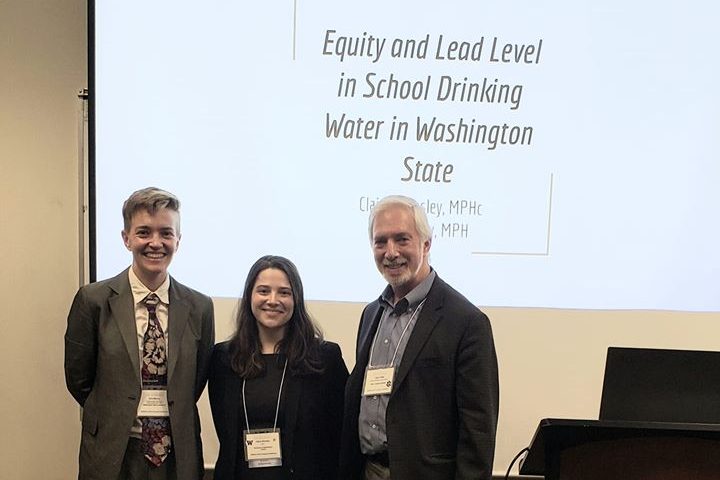Immediate lead mitigation and remediation plans are required after elevated levels were detected in drinking water at several schools in Edmonds School District thanks to a recent law authored by HSPop instructor and WA State Rep. Gerry Pollet, with help from his former MPH students.

Unlike adults, children’s brains and nervous systems are highly sensitive to the damaging effects of lead. Even low levels of exposure can leave them with lifelong cognitive impairments and behavioral issues, especially for children aged six and under. Adults exposed to lead face increased risks of kidney damage, high blood pressure, and other cardiovascular problems. In school drinking water sources, most lead exposure comes from corrosion of older plumbing materials, according to the EPA. Lead can also build up in infrequently used water fixtures.
A 2018 survey by the Government Accountability Office reported that only 43% of U.S. school districts had tested for lead in drinking water, and 37% of those districts tested high enough to require remediation.
New requirements for lead testing in schools

Thanks to a 2021 law authored by State Rep Gerry Pollet, lead testing and corrective measures are now underway in schools across the state of Washington.
Under the state law, every single drinking water fixture must be tested for lead in public K-12 schools built or with plumbing replaced before 2016. Water sources with lead levels over 15 parts per billion (ppb) must be shut down immediately and remain inaccessible until remediation is complete or the fixture has been permanently shut off. Those measuring between 5-15 ppb require remediation and retesting within six months.
School districts are also required to report findings and action plans with students’ families and staff. Throughout this process, the WA DOH provides technical assistance and guidance to school districts.
Mandatory lead testing proves consequential for Edmonds School District
The Edmonds School District underwent sampling this spring and reported remarkably high water lead levels in multiple schools. So far, every school tested in the district has had at least one water source requiring remediation within six months. Notably, a kindergarten classroom sink at Sherwood Elementary School measured 323 ppb, over 20 times the limit requiring immediate shutoff until remediation is complete.
State Rep. Pollet told My Edmonds News that this level is of considerable concern, “That’s why we’re testing every single classroom.”
Hilltop Elementary had a sink faucet measuring 285 ppb, and three more over 80 ppb. A library drinking fountain in Edmonds Elementary measured 43 ppb. “Lack of regular water use in certain locations can cause stagnant water to remain in contact with lead-containing materials longer, potentially increasing lead concentrations,” said Curtis Campbell, the district’s director of communications and public relations.
Chase Lake Elementary, Hazelwood Elementary and Seaview Elementary didn’t have any water sources over 15 ppb. It’s also worth noting that water samples varied widely within schools, not just across buildings, but from room to room.
Full reports detailing the exact water fixture locations, types, and lead measurements are available on the Edmonds School District website. Thus far, 12 reports are available of the 35 schools in the district, which serves Edmonds, Lynnwood, Mountlake Terrace, Woodway, Briar, and parts of unincorporated Snohomish County.
Identifying lead in school drinking water across WA state
Since testing became mandatory across Washington state, 7.9% of water fixtures sampled tested between 6 – 15 ppb and 2.8% tested greater than 15 ppb. Every school has until June 30, 2026, to undergo testing, with retesting required every five years.
During the 2023-2024 academic year:
- A sink in the wood shop of Monroe School District’s Sky Valley Education Center, also in Snohomish County, measured 998 ppb.
- Four school sinks in King County tested above 100 ppb, with the highest reading of 293 ppb in a sink at Glacier Park Elementary School in Tahoma School District.
- Pierce County’s highest reading of 243 ppb was in a snack bar sink at Pioneer Middle School in Steilacoom Historical School District.
- Wahkiakum High School had five water sources that required immediate shutdown, with a library sink reading 710 ppb.
Find more results on WA DOH’s compiled test results page, which will be updated this summer to reflect this year’s results.
In terms of identifying lead poisoning in individual children, testing rates are extremely low in Washington compared to other states. Snohomish County, where Edmonds School District operates, has even lower testing rates than the state average. Although the county saw a 3.1% increase in testing rates from 2020-2023, after the SnoCo Health Department received federal funding to support their work preventing childhood lead poisoning. WA DOH provides a lead exposure risk map.

How COPHP MPH students’ capstone projects contributed to passing the law
In addition to his role representing the 46th District in the WA Legislature, Rep. Pollet also serves as a clinical instructor in the University of Washington Department of Health Systems and Population Health. He teaches environmental health as well as the policy block for the Community-Oriented Public Health Practice MPH program.
A regular collaborator with COPHP students in his legislative work, Rep. Pollet credits two of their culminating MPH projects with reducing lead exposure in schools.
“The state law requiring testing for lead in schools and setting a strong protective standard is the result of two capstones by MPH candidates Claire Woosley and Molly Codding,” said Rep. Pollet.

Now both alumni, Claire Woosley and Molly Codding worked on the bill through their capstone projects over two sequential years, with Rep. Pollet as their faculty advisor. They also received mentorship from COPHP alum, Saturn McCoy, who served as Rep. Pollet’s legislative aide from 2019-2021.
Woosley’s capstone work on school water lead levels involved producing and presenting an equity analysis and recommending proposed legislation. With support from the Marcy Migdal Fellowship for Educational Equality and COPHP’s travel award, she shared her findings at the 2019 WSPHA annual conference.
She also testified before the WA State House Education Committee in support of the law. However, the legislation did not pass that year.

So, for the 2021 legislative session, Rep. Pollet continued work to strengthen the bill and brought in Codding to build upon Woosley’s foundational work.
Codding performed a literature review and formed a health impact review. She also prepared for the session by updating the analysis of state-reported lead water testing. Produced key stakeholder communication materials, including policy memos, slide decks, FAQ sheets, and one-pagers. She also presented this work at the WSPHA annual conference and testified in support of the bill in committee hearings.
Codding received the UW SPH Outstanding Master’s Graduate Student award in 2021. That year, she told HSPop, “We can protect children with only a modest financial and infrastructure investment. Simply replacing leaded-brass valves and faucets with parts that contain no lead, or placing certified filters at water outlets, is enough to eliminate this dangerous problem.”
House Bill 1139 – “Taking action to address lead in drinking water” passed the 2021 legislative session and went into effect later that year.
Woosley now works as an immunization emergency response planning coordinator for WA DOH, and Codding is a community environmental justice coordinator for the Minnesota Department of Natural Resources’ urban forestry program.
Challenges to safety from lead and chemical exposure
In addition to drinking water, lead exposure can occur through the air, soil, food, and consumer products. Over the past several decades, public health professionals and lawmakers have dramatically reduced exposure to lead and many other environmental contaminants — through research, advocacy, and regulation.
However, several recent cuts to federal-level funding and regulations pose a threat to public water supplies and systems. To name a few, congress passed a spending bill this year that cuts rural water funding by 20%, and the EPA announced that it will reconsider wastewater regulations for oil and gas development and rescind limits on PFAS in drinking water.
Despite federal rollbacks, the news from Edmonds School District highlights how public health research and advocacy leads to meaningful, preventive action driven by communities, students, lawmakers, and public health departments working together. Lead detection and remediation in schools across the state can serve as a model for how public health efforts here in Washington create more safe and healthy learning environments.